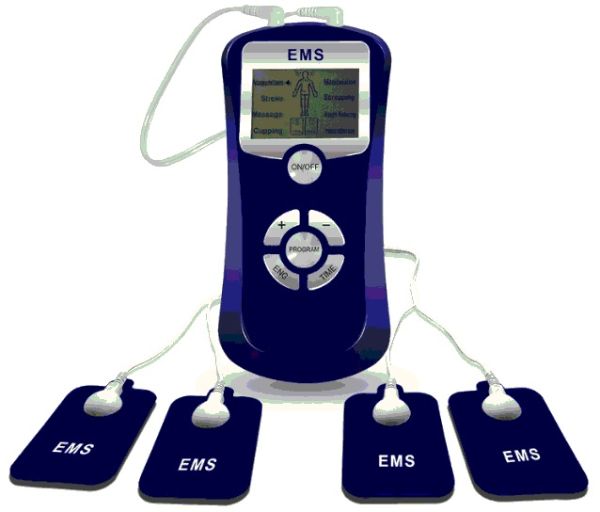Whether you’re a fitness enthusiast, an athlete, or just someone who occasionally hits the gym to break a sweat, you know the familiar post-workout feeling: sore muscles. The kind of soreness that makes even simple movements a challenge. Fortunately, technology has blessed us with tools that promise to soothe those aching muscles – EMS (Electrical Muscle Stimulation) and massage guns.
It’s time to pit these two contenders against each other in a battle for muscle relief supremacy. So get ready for the ultimate showdown: EMS vs. Massage Gun.

Table of Contents
Round 1: How They Work
EMS: EMS involves using electrical impulses to stimulate your muscles. These impulses mimic the signals that your brain sends to your muscles during exercise, causing them to contract and relax. It’s like a mini workout without actually moving a muscle. EMS devices typically come in the form of wearable pads that you attach to specific muscle groups.
Massage Gun: Massage guns, on the other hand, are handheld devices that use percussive or vibration therapy to target sore muscles. They deliver rapid bursts of pressure to your muscles, helping to increase blood flow, reduce muscle tension, and alleviate soreness.
Round 2: Muscle Activation
EMS: Electrical Muscle Stimulation aims to activate muscles that may not be engaged during your regular workout. It’s like waking up those sleepy muscles and giving them a gentle nudge to join the party. This can be particularly beneficial for recovery and rehabilitation.
Massage Gun: Massage guns work by relaxing and soothing muscles that are already activated. They provide a deep tissue massage effect, helping to release knots, break down scar tissue, and reduce muscle tightness.
See Big Selection of Massage Guns!
Round 3: Convenience and Ease of Use
EMS: EMS devices are relatively easy to use, but they do require you to attach the electrodes to your skin and set the intensity levels. Once you’re all set up, you can go about your day while the device does its magic.
Massage Gun: Massage guns are also user-friendly. You simply turn them on, choose the intensity level, and target the desired muscle group. It’s like having your own personal masseuse on hand whenever you need it.

Round 4: Targeted Relief
EMS: EMS is great for targeting specific muscle groups. If you’ve got a nagging pain or want to give extra attention to certain muscles, EMS allows you to zone in on those areas.
Massage Gun: Massage guns are versatile and can be used on various muscle groups. You can adjust the attachments and pressure to cater to different areas of your body.
Round 5: Suitability for Different Goals
EMS: EMS is a valuable tool for recovery, muscle activation, and injury prevention. It’s commonly used by athletes and individuals undergoing physical therapy.
Massage Gun: Massage guns are perfect for alleviating muscle soreness and tension. They’re also popular for improving flexibility and enhancing overall muscle function.
Round 6: Potential Side Effects
EMS: When used correctly, EMS is generally safe. However, improper use or excessively high intensity levels could lead to muscle fatigue or discomfort.
Massage Gun: Massage guns are safe for most people, but they should be used with caution, especially if you have sensitive areas or existing injuries. Applying too much pressure or using the device for extended periods could cause bruising or discomfort.
Final Round: Making the Choice
When it comes down to it, the choice between EMS and a massage gun depends on your individual needs and preferences.
Choose EMS if:
- You want to target specific muscle groups.
- You’re looking to activate muscles for recovery or rehabilitation.
- You prefer a hands-free approach to muscle relief.
Choose a Massage Gun if:
- You need quick and effective relief from muscle soreness and tension.
- You want to enhance overall muscle function and flexibility.
- You’re looking for a versatile tool for various muscle groups.
EMS vs. Massage Gun Comparison
| Aspect | EMS | Massage Gun |
|---|---|---|
| How They Work | Electrical impulses mimic muscle contractions | Percussive or vibration therapy for muscle relief |
| Muscle Activation | Targets specific muscles for activation | Relaxes and soothes activated muscles |
| Convenience and Ease of Use | Wearable pads, requires setup | Handheld device, easy to operate |
| Targeted Relief | Effective for specific muscle groups | Versatile, can be used on various areas |
| Suitability for Different Goals | Recovery, muscle activation, injury prevention | Muscle soreness, tension, flexibility |
| Potential Side Effects | Muscle fatigue, discomfort with improper use | Possible bruising, discomfort with excessive pressure |
Conclusion
In the end, both EMS and massage guns have their strengths, making them valuable additions to your fitness and recovery routine. Whether you opt for the soothing vibrations of a massage gun or the gentle muscle contractions of EMS, the goal remains the same – to keep your muscles happy, healthy, and ready for your next workout adventure. So, choose your side, embrace the technology, and wave goodbye to those pesky post-workout muscle blues!